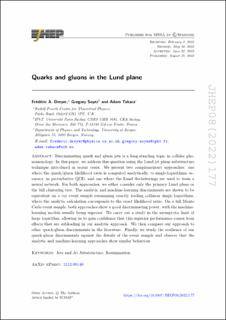| dc.contributor.author | Dreyer, Frédéric A. | |
| dc.contributor.author | Soyez, Gregory | |
| dc.contributor.author | Takacs, Adam | |
| dc.date.accessioned | 2023-03-20T11:49:47Z | |
| dc.date.available | 2023-03-20T11:49:47Z | |
| dc.date.created | 2022-11-08T15:05:52Z | |
| dc.date.issued | 2022 | |
| dc.identifier.issn | 1126-6708 | |
| dc.identifier.uri | https://hdl.handle.net/11250/3059226 | |
| dc.description.abstract | Discriminating quark and gluon jets is a long-standing topic in collider phenomenology. In this paper, we address this question using the Lund jet plane substructure technique introduced in recent years. We present two complementary approaches: one where the quark/gluon likelihood ratio is computed analytically, to single-logarithmic accuracy, in perturbative QCD, and one where the Lund declusterings are used to train a neural network. For both approaches, we either consider only the primary Lund plane or the full clustering tree. The analytic and machine-learning discriminants are shown to be equivalent on a toy event sample resumming exactly leading collinear single logarithms, where the analytic calculation corresponds to the exact likelihood ratio. On a full Monte Carlo event sample, both approaches show a good discriminating power, with the machine-learning models usually being superior. We carry out a study in the asymptotic limit of large logarithm, allowing us to gain confidence that this superior performance comes from effects that are subleading in our analytic approach. We then compare our approach to other quark-gluon discriminants in the literature. Finally, we study the resilience of our quark-gluon discriminants against the details of the event sample and observe that the analytic and machine-learning approaches show similar behaviour. | en_US |
| dc.language.iso | eng | en_US |
| dc.publisher | Springer | en_US |
| dc.rights | Navngivelse 4.0 Internasjonal | * |
| dc.rights.uri | http://creativecommons.org/licenses/by/4.0/deed.no | * |
| dc.title | Quarks and gluons in the Lund plane | en_US |
| dc.type | Journal article | en_US |
| dc.type | Peer reviewed | en_US |
| dc.description.version | publishedVersion | en_US |
| dc.rights.holder | Copyright 2022 The Author(s) | en_US |
| dc.source.articlenumber | 177 | en_US |
| cristin.ispublished | true | |
| cristin.fulltext | original | |
| cristin.qualitycode | 2 | |
| dc.identifier.doi | 10.1007/JHEP08(2022)177 | |
| dc.identifier.cristin | 2070731 | |
| dc.source.journal | Journal of High Energy Physics (JHEP) | en_US |
| dc.identifier.citation | Journal of High Energy Physics (JHEP). 2022, 2022 (8), 177. | en_US |
| dc.source.volume | 2022 | en_US |
| dc.source.issue | 8 | en_US |

